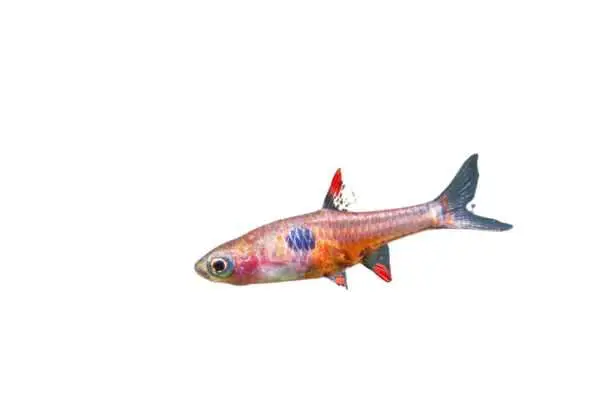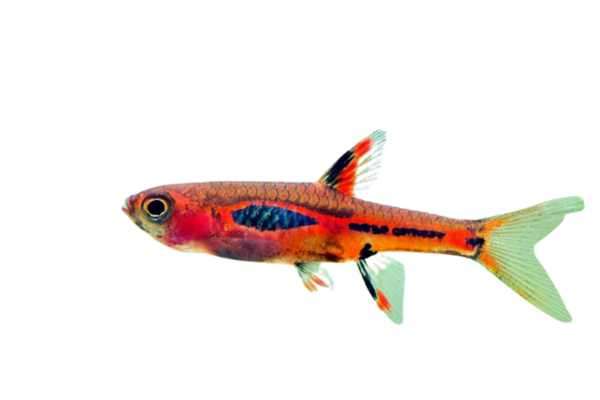Aquarium enthusiasts are well acquainted with the beauty and diversity of aquatic life. Among the captivating inhabitants of our underwater realms, the Strawberry Rasbora and Chili Rasbora stand out as two intriguing species that often steal the spotlight. In this article, we’ll explore deep into the details of these two popular aquarium fish, exploring their unique traits, behaviors, and care requirements. By understanding the subtle and not-so-subtle differences between them, you’ll be better equipped to create a thriving aquatic environment that caters to their specific needs.
So, buckle up and get ready to explore the fascinating differences between these two popular fish pals. Whether you’re a seasoned fishkeeper or just getting started, understanding their unique traits will give you the upper hand in creating a thriving aquatic haven. Let’s dive in and discover what makes these fishy friends stand out!
Overview Comparison: Strawberry Rasbora Vs. Chili Rasbora
Here’s a comparison table highlighting the differences between Strawberry Rasbora and Chili Rasbora:
| Aspect | Strawberry Rasbora | Chili Rasbora |
|---|---|---|
| Scientific Name | Boraras naevus | Boraras brigittae |
| Body Size | About 1 inch (2.5 cm) | About 1 inch (2.5 cm) |
| Coloration | Vibrant red, resembling strawberries | Fiery red with subtle color variations |
| Fin Structure | Slender fins and forked tail | Delicate fin rays and unique tail shape |
| Native Regions | Streams and rivers in Southeast Asia | Ponds and sluggish rivers in Southeast Asia |
| Habitat Conditions | Clear, slow-moving waters | Submerged vegetation, gentle water flow |
| Temperature Range | 73°F to 82°F (23°C to 28°C) | 73°F to 82°F (23°C to 28°C) |
| pH Range | Slightly acidic to neutral | Slightly acidic to neutral |
| Schooling Behavior | Strong tendency to school | Exhibits shoaling tendencies |
| Interaction with Tankmates | Peaceful, social nature | Compatible with non-aggressive fish |
| Dietary Preferences | Live foods and small particles | Small insects, larvae, and microorganisms |
| Feeding Frequency | Frequent, small feedings | Multiple feedings throughout the day |
| Tank Size Requirement | At least 10 gallons | Similar tank size as Strawberry Rasbora |
| Water Parameters | Consistent temperature and pH | Stable temperature and pH |
| Maintenance Routine | Regular water changes and filtration | Regular water changes and monitoring |
| Breeding Behavior | Egg-laying, minimal parental care | Egg-scattering, limited parental care |
| Availability | Popular in the aquarium trade | Sought-after choice for enthusiasts |
| Approximate Cost Range | $3 to $5 per fish | $3 to $6 per fish |
Detail Comparison: Strawberry Rasbora Vs. Chili Rasbora
Physical Characteristics
Strawberry Rasbora: The Strawberry Rasbora, known scientifically as
Boraras naevus, boasts a petite yet charming presence in aquariums. Its body, reaching about an inch in length, showcases a streamlined shape that facilitates swift movement through the water. The defining feature of this rasbora is its striking red hue, reminiscent of a ripe strawberry, that spans its entire body, creating a stunning visual contrast against the aquatic backdrop. Its slender fins and forked tail add an elegant touch, completing its captivating appearance.

Strawberry Rasbora (Boraras naevus)
Chili Rasbora: In the world of aquarium fish, the Chili Rasbora, scientifically labeled as C, is a true gem that commands attention. Though similarly sized to the Strawberry Rasbora, its physical attributes set it apart. The Chili Rasbora exhibits a rich red coloration, akin to the fiery glow of chili peppers. What makes this species stand out even more are the subtle variations in its red hues, contributing to a mesmerizing interplay of shades. The fin structure of the Chili Rasbora is equally noteworthy, with its fins sporting delicate rays that enhance its graceful movement. Additionally, its tail features a unique shape that adds an artistic flair to its overall appearance.

Chili Rasbora (Chilli Rasbora)
Natural Habitat and Origin
Strawberry Rasbora: Originating from the captivating aquatic landscapes of Southeast Asia, the Strawberry Rasbora calls the clear, slow-moving streams and rivers of the region its home. These water bodies, often characterized by lush vegetation and a tranquil ambiance, provide the ideal conditions for the Strawberry Rasbora to thrive. Native to regions such as Thailand and Malaysia, this species is accustomed to temperatures ranging from 73°F to 82°F and a slightly acidic to neutral pH level.
Chili Rasbora: Hailing from similar Southeast Asian territories, the Chili Rasbora can be found gracing the waters of ponds and sluggish rivers. Its preferred habitats offer a blend of submerged vegetation, gentle water flow, and ample hiding spots. Like its Strawberry counterpart, the Chili Rasbora is accustomed to temperatures between 73°F and 82°F and a slightly acidic to neutral pH range. These conditions mirror its native environment and contribute to its well-being in aquarium setups.
Behavior and Temperament
Strawberry Rasbora: When it comes to social dynamics, the Strawberry Rasbora is a species that thrives on companionship. This rasbora exhibits a natural inclination toward schooling behavior, forming tight-knit groups that provide security and reduce stress. Its social nature extends to its interaction with tankmates, as it tends to coexist harmoniously with a variety of peaceful fish species, making it an excellent addition to community aquariums.
Chili Rasbora: The Chili Rasbora, much like its Strawberry counterpart, demonstrates an affinity for group living. Shoaling tendencies are at the heart of its behavior, and being in the presence of fellow Chili Rasboras is essential for its comfort and well-being. These tendencies can be observed in aquarium settings, where they often move as a synchronized unit, creating a mesmerizing display of unity. This species is known for its compatibility with other non-aggressive fish, fostering a serene aquarium atmosphere.
Diet and Feeding Habits
Strawberry Rasbora: Catering to the dietary preferences of the Strawberry Rasbora involves providing a mix of live foods and finely crushed dry foods. This species thrives on small particles, such as brine shrimp and micro worms, which mimic its natural diet in the wild. To ensure optimal health, it’s recommended to offer frequent, small feedings, as their small stomachs benefit from a consistent intake of nourishment.
Chili Rasbora: The dietary needs of the Chili Rasbora are met through a diet rich in small insects and larvae. This species relishes the consumption of microscopic organisms and tiny aquatic creatures. When setting up their feeding regimen, consider providing a variety of live and frozen foods that mimic their natural prey items. By catering to their nutritional requirements and offering multiple feedings throughout the day, you’ll be promoting their well-being and vibrant coloration.
Tank Requirements
Strawberry Rasbora: Creating an optimal living environment for the Strawberry Rasbora involves selecting an aquarium with dimensions that accommodate their schooling behavior. A tank size of at least 10 gallons is recommended to ensure ample swimming space. Additionally, maintaining a stable water temperature between 73°F and 82°F, along with a pH level ranging from slightly acidic to neutral, supports their health and vitality.
Chili Rasbora: For the Chili Rasbora, an aquarium with dimensions similar to that of the Strawberry Rasbora is suitable. Providing a spacious yet well-arranged environment allows them to exhibit their natural behaviors and thrive. Ensuring water parameters remain consistent, with a temperature range of 73°F to 82°F and a slightly acidic to neutral pH, contributes to their overall well-being.
Aquarium Maintenance
Strawberry Rasbora: Maintaining a clean and suitable aquatic habitat for the Strawberry Rasbora involves regular maintenance routines. Implementing a proper water change schedule, typically around 25% every two weeks, aids in maintaining water quality. Additionally, investing in a reliable filtration system helps remove impurities and ensures a stable environment for these delicate fish.
Chili Rasbora: To uphold the health of the Chili Rasbora and its tankmates, consistent water quality is paramount. Regular water changes of around 25% every two weeks assist in maintaining optimal conditions. The use of a well-functioning filtration system, coupled with monitoring water parameters, contributes to the longevity and vibrancy of this species.
Breeding and Reproduction
Strawberry Rasbora: Breeding the Strawberry Rasbora requires careful consideration of their preferences. Creating an environment with plenty of hiding spots and fine-leaved plants encourages their breeding behavior. This species practices egg-laying reproduction, and if successful, diligent removal of adult fish post-spawning ensures the safety of the eggs. While parental care isn’t typically observed, providing a separate breeding tank can increase the chances of survival for the fry.
Chili Rasbora: The Chili Rasbora’s breeding behavior centers around their natural inclination for egg-scattering. Introducing a separate breeding tank with ample plants for egg protection enhances their breeding success. While parental care is limited, the provision of optimal water conditions, including gentle water flow and slight dimming of lights, encourages the natural reproductive behaviors of this species.
Availability and Cost
Strawberry Rasbora: The Strawberry Rasbora’s captivating appearance and compatibility with community aquariums contribute to its popularity in the aquarium trade. Prices for Strawberry Rasboras can vary, with individual specimens often available for around $3 to $5, depending on factors such as size and availability.
Chili Rasbora: The Chili Rasbora’s alluring red hues and peaceful demeanor have made it a sought-after choice for aquarium enthusiasts. Availability may vary, influencing the cost of individual Chili Rasboras, which typically ranges from $3 to $6 per fish. As with any aquarium investment, considering the long-term care requirements is essential to ensure a thriving aquatic community.
Frequently Asked Questions (FAQs)
What’s the key difference between Strawberry Rasbora and Chili Rasbora’s appearance?
Answer: When it comes to looks, Strawberry Rasboras sport a captivating red hue reminiscent of ripe strawberries, while Chili Rasboras flaunt fiery red shades with delightful variations, making them a visual treat in any aquarium.
Are these fish friendly and sociable with other tankmates?
Answer: Definitely! Strawberry Rasboras are all about the squad life, forming tight-knit schools that exude unity. Chili Rasboras are social butterflies too, showcasing a shoaling behavior that brings a lively touch to your tank. They usually get along famously with peaceful tankmates, making them ideal companions for a harmonious aquatic community.
What’s the secret to keeping these fish healthy and happy?
Answer: Think of it as a recipe for success: for both species, maintaining a cozy water temperature between 73°F and 82°F and a slightly acidic to neutral pH is the way to go. Offering a balanced diet, with a mix of live and frozen foods, ensures they stay in tip-top shape. Oh, and remember to keep the water clean through regular changes and good filtration – they’ll thank you for it!
How big of a tank do Strawberry Rasboras and Chili Rasboras need?
Answer: These little beauties aren’t picky when it comes to space. A tank size of around 10 gallons is just perfect to let them stretch their fins comfortably. Just make sure they have room to swim and explore, and they’ll reward you with their playful antics.
Are breeding Strawberry Rasboras and Chili Rasboras a challenge?
Answer: Breeding these gems is an adventure! Strawberry Rasboras lay eggs, and if you provide plenty of hiding spots and tender care, they’ll do their thing. On the other hand, Chili Rasboras are all about scattering their eggs, but with the right setup and conditions, you’ll witness their natural breeding magic unfold.
Conclusion
As we conclude this exploration of the captivating world of aquarium fish, it’s evident that the Strawberry Rasbora and Chili Rasbora bring unique qualities to any aquatic setting. By delving into the subtle nuances of their physical attributes, behaviors, and care requirements, you’ve gained valuable insights into these remarkable species. The importance of selecting the right fish for your aquarium based on personal preferences and tank conditions cannot be understated. As you embark on your journey as a responsible fishkeeper, continue to expand your knowledge and appreciation for the diverse array of aquatic life that enriches our underwater landscapes. Happy fishkeeping!

